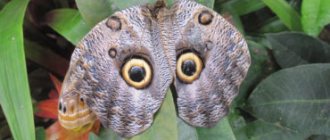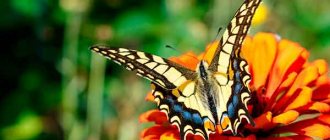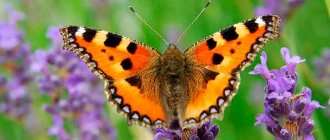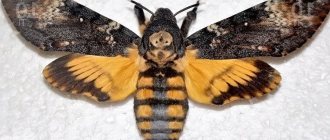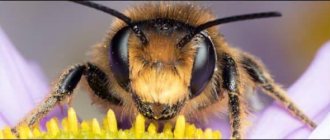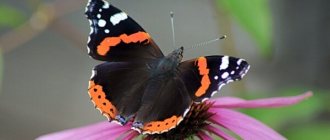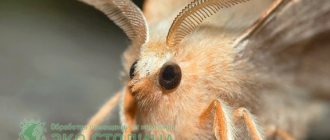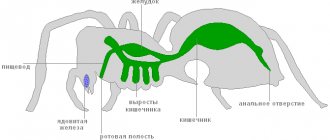A striking representative of the nymphalid family, the peacock eye can be seen in early spring. It is found in parks, gardens, forests and meadows. This species is considered one of the most beautiful in the world. Red-brown wings with bright eyes attract close attention. Watching a fluttering moth, you want to know about its lifestyle. No less interesting is how the peacock butterfly winters?
How butterflies winter
Insects survive unfavorable conditions in winter in different ways.
The vast majority of them in temperate climates fall into a certain state called diapause in winter. Diapause is partly similar to the state of suspended animation in vertebrate warm-blooded and cold-blooded animals (bears, hedgehogs, frogs, lizards, shrews, moles). During diapause, insects slow down their metabolism and other vital processes. During diapause, the body's resistance to unfavorable external conditions increases, for example, insects become resistant to insecticides. This is what helps them withstand low winter temperatures. The “winter sleep” of insects is very deep, in contrast to the anabiosis of warm-blooded animals, which can be interrupted from time to time by a short awakening, it is the deepest and requires certain conditions for its termination. Winter hibernation of insects, as a rule, depends on the length of daylight hours and the presence of a certain temperature regime.
In winter, insects can be at any stage of their development - from egg to imago (adult insect). In each biological species, diapause is confined to a certain phase of development.
Many butterflies spend the winter in the egg stage. This small egg is placed in the most secluded places. The crimson silkworm spends the winter in the adult caterpillar stage, but this is considered an exception to the rule. Most caterpillars overwinter when they have just emerged from the egg, at an early age.
For butterflies, the most common wintering is in the pupal stage. Some pupae are so hardy that they spend the winter anchored on a tree branch in an open place, without fear of cold winds. Less hardy species, while still caterpillars, choose places inaccessible to winds and rains and there they turn into pupae and overwinter.
Species of butterflies such as lemongrass, urticaria, and burdock spend the winter in the adult stage. They cover their body with wings, like a blanket, hide in bark cracks or hollows and hibernate there.
Mourning butterflies avoid freezing by adding a special cooling liquid to their bodies - natural “antifreeze”, which they themselves produce. This liquid contains so-called cryoprotectors, which protect all fluids and soft tissues in her body from low temperatures.
In general, the behavior of insects in winter also depends on the ecology of the species. Even in very close species of the same genus, but living in different conditions, diapause occurs at different phases of development, and in species of unrelated families - at the same phase if they have a similar lifestyle.
Some butterflies, like migratory birds, head south with the onset of cold weather. The monarch butterfly, which lives in the United States, is capable of flying thousands of kilometers. Russia also has a migratory butterfly. This is a burdock, a nomadic butterfly. The first generation of this butterfly migrates south in the fall, and the second generation migrates north in the spring.
Life cycle
The life cycle of lepidoptera begins with the laying of eggs by adult insects directly on the leaves or branches of plants, where the butterfly (or rather its egg) lives in the first stage of its development, which lasts 8-15 days. The color, number and shape of eggs depend on the species; there can be up to 1 thousand eggs in total, most of which do not survive to adulthood. Butterfly species that live in temperate climates typically lay their eggs in late fall or early winter and remain dormant until spring.
The next stage, caterpillars, also takes place on the plants on which they feed. According to their lifestyle, they are divided into those who openly crawl over leaves and branches in search of food, and those that hide under special covers made independently using silky threads and parts of leaves. Some caterpillars are bright in color, demonstrating their inedibility, while others disguise themselves as green parts of plants.
The duration of the life cycle depends on the temperature and climate where butterflies live in nature: in northern species, caterpillars can hibernate (diapause) until next spring, and their development cycle can last up to 7-10 years.
The most stationary stage - the pupa - looks like a light-colored cylinder; as it matures, the color changes to that which is characteristic of this species. Pupae can either attach to leaves or lie on the ground without feeding for a long time.
An adult butterfly (imago) crawls out of the pupa, pushing off the shell with its paws, and males are born earlier than females. After emerging from the shell, its wings gradually straighten and harden, and a characteristic coloring also appears.
How do ants winter
Ants survive the winter in a state of dormancy and inactivity. The forms of inactivity are varied; even the larvae of some species enter a state of diapause. However, adult ants in most species overwinter in a state of reduced activity.
In winter, ants stop their development: the larvae stop growing and stop pupating, the queen stops laying eggs, and the last pupae complete their metamorphosis. Working ants, preparing for winter, absorb aphid secretions especially actively. They contain sugar, which is converted into glycerol inside the ant's body. In the total weight, its share can reach 30%. This is how insects preserve themselves, since fatty glycerin prevents their bodies from turning into ice.
When cold weather sets in, the ants batten down the main exits from the anthill, leaving only ventilation holes, and descend into the deepest rooms of their home. In an anthill, passages and caves can go 3-4 meters deep. The harsher the winter is expected, the further the ants hide from the surface. In underground rooms, the temperature remains at levels from -1.5 to -2 degrees.
For diapause species, hibernation is such a natural and unchangeable event that even at home, with ideal stable temperature and humidity, with the arrival of autumn, ants stop their development and enter diapause.
In non-diapause species, if you dig up an anthill in winter, you can see that the insects do not sleep, but are in a slow state. They are not capable of attacking a trespasser, but instinctively secrete acid and swing their mandibles.
How do mosquitoes spend the winter?
Mosquitoes spend the winter in a state of diapause. Diapause can occur at the egg, larval or adult stages of the insect (imago). Each mosquito species has its own diapausing stage.
If mosquitoes overwinter in the stage of an adult insect (imago), then when they enter a state of diapause, the reproduction of females stops, the metabolic rate decreases and large fat reserves accumulate, due to which they live in the winter-spring period. Male mosquitoes, as a rule, do not hibernate and die in the fall after fertilizing females.
Most mosquitoes overwinter in the egg stage. At this stage, mosquitoes become most resistant to unfavorable environmental factors and, above all, to low winter temperatures. It is at the egg stage that most species of mosquitoes living in the northern regions overwinter.
Larval diapause also occurs in various genera of mosquitoes. The main feature of mosquito larval diapause is a delay in development and cessation of pupation.
Mosquitoes overwinter both in natural shelters (under bark, in dry grass, in the roots of trees, animal burrows, caves, etc.) and in artificial shelters (adits, vegetable stores, cellars, unheated outbuildings and basements, catacombs) . Most mosquitoes do not feed on blood in winter.
Where and how do flies hibernate?
The wintering process occurs differently for each species of fly. Most often, the flies that we meet in our apartments are of the housefly species. It is known that the lifespan of an adult fly is about a month, but if the fly appears in the fall, then it hibernates during the winter cold. Before the onset of cold weather, female flies make their last clutches of eggs. However, those larvae that did not have time to turn into insects do not die, but fall asleep. They can survive almost any climatic conditions. Individuals that have recently turned into adults also fall asleep. With the onset of the first cold weather, flies hide in various cracks, window frames and other places where an even cool temperature is maintained throughout the winter period. Those flies that live in fields, vegetable gardens and orchards also hibernate. For their wintering they look for a place in the ground, but this very often does not save them from frost. Most flies die from the cold.
The surviving flies begin to come to life as the weather warms up. After a long winter hibernation, the fly at first walks as if sleepy, staggering from one side to the other. This is where the expression “sleepy as a fly” comes from. After some time, the insects get used to it and begin to live an ordinary normal life.
How butterflies overwinter in nature, you will learn from this article.
Where do butterflies winter and how do butterflies winter?
Butterflies are amazing creatures that are so similar to real flowers. And in the summer we have the opportunity to observe their fantastic beauty and brightness.
What does a butterfly do in winter?
Probably, few people have thought about how these fragile, airy creatures survive harsh, cold winters. Maybe they, like migratory birds, fly away to distant, warm lands? To some extent this is true. Then another question arises - where? It is difficult to imagine the place where butterflies spend the winter, how many kilometers they, so small, fly on their way.
It all depends on where the butterflies live and on their species. Some fly to hot Africa and Mexico, while others fly to closer, warmer places. Having arrived at the place, they leave their offspring here, who will then return home.
But most species of butterflies have a very short life span - from several days to a couple of weeks. That is why many simply do not live to see winter. It is worth noting that they go through several stages in their life: from a caterpillar from an egg, to a pupa and, in fact, to the butterfly itself. And the fluttering beauties spend the winter in one of these states, although each species is in a different phase.
Some survive the winter in an egg state. In this case, they hide from the cold in the bark of trees - here it is not felt so strongly. Others spend the winter as a caterpillar, wrapped in leaves or in their web.
When do butterflies hibernate?
With the beginning of autumn, these fluttering creatures, as you already understood, fall into a state of suspended animation or fly away to warmer climes. And only with the first signs of warmth do they leave their wintering grounds. This happens in the spring.
We hope that from this article you learned where butterflies go in winter.
Diet in the wild
We all know that every butterfly was originally a caterpillar. So, in the caterpillar stage, it eats a lot, providing itself with food even after it becomes a butterfly. But the protein reserves that the caterpillar deposits in its body are not enough. When they are used up, she has to look for food to maintain vitality.
It would be wrong to say that butterflies eat, since their feeding method is “sucking”. They don't have a mouth as such. Instead, there is a “folding” proboscis with which the insect sucks up food.
It is clear that it will not be possible to suck up anything rough with its proboscis, so the entire diet of a wild butterfly consists mainly of nectar and pollen.
Another favorite delicacy is rotten fruits (pears, apples). They cannot chew, but they can easily suck the juices out of decaying fruits. Moreover, they are rich in sugar.
Also, many may have noticed that they eat bird droppings and manure. The fact is that it contains many microelements that they need for normal existence. Therefore, they do not disdain such a “fragrant” delicacy.
They also love salt. But it is very difficult to get it in the wild. Therefore, many insects get it from human sweat in the summer. You can often see butterflies landing on sweaty people in parks. They do not cause any harm to humans, but simply suck sodium out of sweat.
Description of the species
The beauty of butterflies invariably attracts the admiring glances of fauna lovers. The photo shows one of the amazing creations of nature, the peacock butterfly. She is a typical inhabitant of garden plots and forest clearings. Prefers free, well-lit areas rich in flowering vegetation. In dense forests, she runs the risk of damaging her scaly wings on tree branches.
Insect taxonomy:
- family - Nymphalidae;
- genus – Aglais (urticaria);
- species – Inachisio Daytime peacock eye.
The family of nymphalids is characterized by variegated wing colors on the outside and protective colors on the inside. Many of its representatives tend to migrate in search of better food places. The genus of wrens is not numerous, it includes only 6-7 species, including the day peacock butterfly.
Information. The history of the Latin name of the species is associated with Greek mythology. Inachis is the name of the river god Inach, Io is his beautiful daughter.
The peacock eye is not large in size, the length of its front wings is 30 mm, the span is 60-62 mm. The wings are wide, the outer edge with serrations and angular projections. Their main background is reddish-brown or red. A grayish-brown stripe runs along the edges. At the top of the front and rear pairs of wings there is a characteristic pattern in the form of an eye with a blue center. It is surrounded by yellowish, white and black rings. In the description of the peacock butterfly, one should note the protective coloring on the underside of the wings. On a dark background, light brown sinuous lines create an imitation of a dry leaf.
Interesting fact. The color intensity is affected by the temperature at which the pupa developed.
The head is round, the mouthparts are of the sucking type, with a proboscis. The antennae are club-shaped. The eyes are complex, faceted, and shaped like hemispheres. The chest consists of three segments. The front legs are reduced. They are not used when walking; insects move on their middle and hind legs. In the middle of the front shin there is a spur for cleaning the antennae. Sexual dimorphism is manifested in the structure of the antennae and size - females are slightly larger than males.
This is interesting: What do ladybugs eat and what do they look like?
Preparing for winter
How does the peacock butterfly prepare for the cold winter? After emerging from the pupa, the imago begins to actively feed. Insects that go to sleep during the cold season diligently store nutrients from the end of summer. Their main diet is nectar from flowering plants: elderberry, dandelions, clover, lavender. Rotten fruits and tree sap help stock up on nutrients for several months of suspended animation.
Selecting a location
The peacock butterfly hibernates in temperate latitudes in September and in the south in October. She chooses a safe place where she will be sheltered from the cold and enemies. It could be:
- attic of a house or outbuilding;
- a cavity in the bark of a tree;
- hollow;
- cave and rock crevice;
- forest or meadow litter.
Winter hibernation is called hibernation. During this period, all life processes slow down (breathing, digestion), and body temperature decreases. The duration of torpor depends on environmental conditions. Sleep may be interrupted as a result of rising temperatures. The butterfly chooses a secluded place; if it is a vertical surface, it clings tightly with its paws. Motionless, with dark folded wings, it looks like a dry autumn leaf.
Advice. If you find a peacock butterfly hibernating in a dry, comfortable place, do not disturb it. The insect will sleep peacefully until spring.
Where does the great night peacock butterfly live?
The pear peacock eye is a heat-loving, frost-intolerant, exclusively southern species of butterfly. The range of this species covers southern and partly central Europe, the Mediterranean from the Iberian to the Balkan Peninsula, the Czech Republic, Slovakia, southern Romania, Ukraine, and the southern European regions of Russia. Also, the large night peacock eye lives in North-West Africa (Algeria, Morocco), Turkey, the Middle East, the Caucasus, Transcaucasia, and inhabits countries such as Georgia, Armenia, Azerbaijan, Iran, Israel, Syria, Lebanon.
The Saturnia pear butterfly lives in gardens, parks, on the edges of deciduous forests, in open forests, and on bush-covered slopes. Occasionally, individual individuals are found in more northern regions, but since these butterflies are not prone to migration, this can most likely be explained by the fact that their pupae, caterpillars or laid eggs came north along with fruits sent for sale from the southern regions. But these cases are isolated and not typical. Perhaps, with the onset of global warming, the great nocturnal peacock will expand its territory of residence.
Photo credit: Avereanu, CC BY-SA 3.0
Biology
Butterflies are found in broad-leaved, mainly valley and floodplain forests, often with an admixture of wild fruits (apricot, cherry, sweet cherry, pear, walnut); in open forests, among shrubby wastelands, in parks and gardens, on forest edges, and fruit plantations.
The flight time of butterflies lasts from May to June. Butterflies are active in the evening and at night; males sometimes also fly during the daytime. Females are sedentary, usually do not fly and sit motionless, waiting for males, who find their locations thanks to sex pheromones. French entomologist Jean Henri Fabre discovered that male pear peacock eyes can fly to the smell of pheromones from a female located at a distance of 10-11 kilometers from them.
After mating, the female lays several hundred eggs. Caterpillars develop from June to August. The caterpillar is large, bright green. On the dorsal surface of the caterpillar's body there are long club-shaped hairs thickened at the end, located on blue (sometimes pink) stalk-like warts. The spiracle is red, and there is a bright red spot above the anal plate. Before pupation, the green caterpillar turns brown. Food plants for caterpillars: fruit trees from the Rosaceae family (apple, pear, cherry, plum, thorn, less often - walnut, elm, ash, etc.). They pupate at the end of August-September - in an egg-shaped dense cocoon of brown color. The pupa is brown in color, the wing sheaths are black, and there is a brown-red notch on the abdomen. The pupa overwinters, sometimes twice.
Lifestyle
The main method of movement of butterflies is flight. It can be active with flapping wings or passive - gliding. Sometimes insects make long flights in search of food. What does the peacock butterfly eat? Like most lepidopterans, it sucks nectar from flowers. Among the insect's taste preferences:
- dandelions;
- marigold;
- elder;
- clover;
- marjoram;
- buddleya.
In addition to nectar, they consume the sweet juice of slightly rotten fruits and drink secretions on tree bark.
Peacock's eye is a diurnal butterfly that is active during daylight hours. In mid-latitudes, one generation is replaced per year; in the south, two generations manage to develop. The first generation of adults appears in June-July, the second in August-September. How long does a peacock butterfly live? Among insects, she is a long-liver - her life span is almost a year. The butterfly spends a significant part of the cycle in a state of suspended animation or hibernation.
Butterfly wintering
One of the notable features of the butterfly is its wintering in the adult state. With the onset of cold weather, representatives of the second generation look for reliable shelters for the cold season. They hide in the forest floor, under the bark of trees, in the cracks of outbuildings, and in attics. By folding their wings, insects fall into suspended animation, their life processes slow down. In winter, butterflies find themselves defenseless against attacks from predators; if there is insufficient accumulation of nutrients, they can die of starvation. Premature rise in temperature is dangerous. During the thaw, the peacock's eye wakes up and leaves its shelter. The second time it is more difficult for the insect to settle down for the winter.
Defense mechanism
Butterflies have many natural enemies, these include birds, rodents, reptiles, and large insects. To frighten the enemy, the peacock's eye has an unusual coloring. When attacked by birds, the butterfly suddenly opens its wings. The appearance of widely spaced eyes disorients the predator, and in some cases forces it to retreat. Even a short delay is enough for an insect to escape from the enemy.
Appearance of butterflies, where they live and what they eat
Among invertebrates, butterflies have the most complex body structure and the most beautiful appearance. The insect's body consists of an abdomen, chest, head with antennae and proboscis, 3 pairs of legs and two pairs of beautiful wings, which contain all the beauty of nature, various patterns and colors.
The butterfly has a total of 4 wings, each of which is covered with scales ranging from 100 thousand to 1 million in larger tropical species. They are: pigment (containing a bright coloring matter) and optical (reflecting and refracting light).
Butterflies feed exclusively on liquids that they can drink through their proboscis: flower nectar, tree sap, pollen, dung and rotting fruit. They can suck moisture from puddles or from leaves, and sometimes sit on a person in search of a drink, attracted by the smell of sweat, which contains salts and minerals necessary for their life.
Life expectancy also depends on where the butterfly lives, its type and size: smaller ones can live only a few days, and large insects living in the tropics can live up to several months. Representatives of middle latitudes live on average 3-4 weeks, and representatives of northern latitudes live up to 2 years.
Related species of butterflies
Butterflies of the peacock-eye family have similar wing colors and eye patterns. These are large insects with a wingspan of 12-15 cm. They are active in the dark. A distinctive feature of the family is its reduced oral apparatus. Insects do not feed at the adult stage. They live off the nutrients accumulated by the caterpillar.
Great night peacock eye
The pear peacock eye or saturnia is a butterfly common in Southern and Central Europe, the Caucasus and Asia Minor. The wingspan is up to 155-160 mm, one wing is 55-70 mm. This is the largest nocturnal butterfly in Russia and Europe. At dusk or mistaken for bats. Females are larger than males, they have short comb-like antennae, and the proboscis is underdeveloped. The main color of the wings is grayish-brown. There is a black stripe at the base, the edges of the front and rear pairs have a light border. Almost in the middle of each wing there is a visible ocellus with a dark center and a light ring.
The summer time of the night peacock butterfly is May-June. This is a heat-loving species that does not tolerate frost. They can be found in North Africa, Turkey, the Mediterranean, southern Europe, the Caucasus, Iran, Syria. Their habitats are forests and parks with a lot of bushes. Females are sedentary, males are much more active, flying even during the day. But females live almost 3 times longer - 20 days versus 8. The favorite food tree of Saturnia caterpillars is pear. But they happily feed on cherries, apples, plums, quinces, almonds, and maples. The caterpillar grows up to 10 cm and changes color several times during its life. The large peacock eye produces one generation per year; the pupa goes to winter.
Attention. The pear peacock eye is listed in the Red Book of Ukraine. In Russia it is protected in the Voronezh, Rostov and Belgorod regions.
Lesser night peacock
The small peacock eye also belongs to the genus Saturnia. Unlike the great peacock's eye, it is found throughout the Palearctic. Wingspan up to 60 mm. The male has reddish-gray forewings and orange hindwings. Females have a more modest coloration of light gray. The pattern is represented by wavy lines and bands of dark brown and yellowish color. Each wing has an ocellus - the middle is dark, the border is black and light.
Adults do not feed and live 3-4 weeks. Caterpillars live on thorns, raspberries, blackberries, willows, birches, and heather. The larvae have to stock up on food for the pupa and butterfly. The insect overwinters at the pupal stage, and begins to fly in April-May.
Butterfly world
Representatives of the order Lepidoptera, which includes butterflies according to the biological hierarchy, can be found on almost all continents and in any climate, except the coldest - Antarctica. They love to fly in flowering meadows in mid-latitudes and among the ice of Greenland, on the islands of the Pacific Ocean and in the highlands of the Himalayas.
Butterflies belong to the most numerous and ancient order, which has more than 158 thousand species. Lepidoptera are cold-blooded (ectothermic) insects that can regulate their own body temperature by taking heat from the outside or releasing it into the environment. Because of this, most of their species prefer to live in tropical climates.
A butterfly is called an insect with complete metamorphosis, i.e. its development goes through all stages: eggs, larvae or caterpillars to pupa and adult (imago). Also, for most lepidopterans, a characteristic feature of their body structure is the presence of a mouthparts with a proboscis, through which they drink nectar. They also have a wide variety of wing shapes and sizes: from 2 mm to 28 cm.
Where the butterfly lives, what it eats and its lifespan most often depend on the climate zone: these insects prefer a hot and humid natural climate, that is, the tropics. The greatest diversity of species lives in the forests of South America (40 thousand), in South and Southeast Asia (more than 10 thousand), where there are ideal conditions for the number of sunny days, high humidity and the possibility of camouflage among dense foliage.
Interesting Facts
- The Saturnia pear moth scares away birds with the help of its coloring: when an enemy approaches, it opens its wings, and the bird, seeing eyes directed at it, gets scared.
- At the beginning of the 20th century, some sources noted Saturnia pear as a minor pest of fruit crops. But the number of the butterfly declined towards the end of the century, and now the pear peacock eye does not cause harm. Although its caterpillars feed on fruit trees, due to their small numbers they cannot significantly damage them. This species of butterfly has no economic importance, unlike some other species of peacock eyes, which are silkworms. But the large night peacock eye invariably pleases people with its beauty.
- The great nocturnal peacock's eye and the great diurnal peacock's eye butterflies are not related, as the former belongs to the peacock eye family and the latter to the nymphalidae family.
- In May 1889, the famous artist Vincent Willem van Gogh, seeing an unusual butterfly in the garden of the Saint-Rémy-de-Provence clinic, was struck by its beauty and immediately made a charcoal sketch, and then a painting emerged from the sketch. The painting depicts a pear peacock eye, although the artist himself mistakenly called it “Death's Head Hawkmoth.” The museum in which it is located has renamed the painting. Now it is called “Imperial moth” (“Peacock-eye”).
- The species is listed in the Red Book of Ukraine as a “rare species” whose numbers are insignificant; only in the south of the country in favorable years is it locally common.
Video
- https://nashzeleniymir.ru/peacock-eye-pear#znachenie-babochki-pavlinoglazki-grushevoj. https://ru.wikipedia.org/wiki/Pavlinoglazki_pear https://animalreader.ru/babochki-pavlinoglazki-opisanie-vidyi.html https://wiki.eanswers.net/ru/Peacock_pear https://bukvasha.ru /referat/262486
How to care for a peacock butterfly
Some wildlife lovers bring insects home. Someone wants to watch the changing stages of their development or just have a piece of beauty at home. It's interesting to grow a butterfly from a caterpillar. It is placed in a container or jar and fed with leaves. When the time comes to pupate, you will need soil. The newly born individual will need time to spread its wings. What to feed a peacock butterfly at home? The insects' diet includes flower nectar and fruit juice. In the warm season, you can bring fresh flowers picked from the area every day.
In winter, it will not be possible to provide the butterfly with nectar, and in a warm apartment it will not hibernate. Flower nectar is an excellent substitute for honey solution. The natural product is diluted with water in a ratio of 1:10. The insect is taken by the body and placed on the edge of a saucer with syrup. The menu includes fresh fruit. An orange, a ripe pear, a banana are cut into pieces and offered to the pet. You will need 1-2 feedings per day. Peacock's eye can be forced into suspended animation. You will need a plastic container with holes for ventilation. In such a house, the insect is taken out to the loggia, where it is dry and cool.
The average lifespan of a peacock butterfly is 3-6 months; with good care, it will delight you with its beauty for a long time. If you plant nettles on your property, there is a real chance of seeing fluttering butterflies every day.
Butterfly farming business
Insects are bred not only for entertainment. It is not difficult to make money from an unusual hobby - the business of raising butterflies is popular. Four common options are:
- Selling butterflies and pupae for home farms via the Internet. Make a website and fill it with information about the product. The cost of pupae starts from 150-200 rubles, depending on the type. The batch includes 15 insects. Think about packaging and delivery issues in advance.
- Organization of exhibitions and photo sessions. Fireworks are often bought for events - insects are released from beautiful boxes at weddings and other holidays. The cost of the service is from 2 thousand rubles. To organize an exhibition, you need to rent a room with an area of 20 square meters, create suitable conditions in it and “populate” it with several dozen exotic species. Tickets for such events are sold for 100-200 rubles.
- Sale of dried insects. A framed butterfly costs from 450 rubles to 20 thousand - the price depends on the type. Anyone can master the design of souvenirs.
- Rent butterflies for photo shoots. Photographers are willing to pay for the service from 500 rubles per hour.
It is not difficult to raise butterflies from pupae. This is a fascinating process that captivates both adults and children with equal force. Create the necessary conditions for insects, and then new exotic residents will soon appear in your apartment.
Keeping at home
Keeping fluttering moths at home is not difficult. The main thing is to adhere to some rules of care.
Nutrition
These insects love to eat nettles. But if it is not there, then you can offer them raspberries, hops or willow. The menu of adult moths may also include plant juice, flower nectar, overripe fruits, and burdocks.
Let's look at what you can feed a peacock butterfly in an apartment. It is recommended to prepare a 10% solution of water and honey for them. Honey must be natural, without preservatives. Instead of honey, you can use sugar by mixing 1 teaspoon in 6 teaspoons of water. You can also add bananas and oranges to your diet after cutting them up. 1-2 feedings per day are enough.
Important! Unlike some other butterfly species that live off stored nutrients, the peacock eye needs to be fed every day.
Lifespan
Very rarely, these insects can live more than 12 months. But on average their life expectancy is 3–6 months. It is impossible to answer the question of how long a peacock butterfly lives at home. It all depends on the conditions of detention. If they are very close to natural habitat conditions, then she can live a long time.
Reproduction
If you want to breed butterflies, you need to have both a male and a female. The place where insects are kept must have a favorable air temperature and a sufficient amount of water and food.
Under such conditions, they can begin to mate, which takes from 30 minutes to 8 hours. At this time, insects should not be disturbed.
Find out all the intricacies of keeping an admiral butterfly at home.
Once completed, the female begins to look for a place to lay her eggs. She usually does this on the leaves of plants. Therefore, when breeding butterflies, it is necessary to provide them with fresh leaves. After the female has laid her eggs, the leaves with them should be placed in a box with high humidity and good ventilation. It should be warm in the “house”. After some time, caterpillars should appear, moving around and looking for an appropriate place for pupation. To do this, they need enough space in their home. It is recommended to feed the caterpillars with fresh leaves every day.
When you see the pupa, it must be removed from the caterpillars to another home. It should have a lot of space and be spacious. To create the necessary humidity in the “house,” you need to wet a towel with water and place it on the bottom.
Once the pupae are formed, you can hang them to make it easier for the butterflies to get out.
Important! Insects remain in the pupal stage for several months, so it is recommended to constantly maintain the required humidity and ambient temperature.
How does it winter
Moths overwinter in cool conditions. If they sleep warm in winter, they may not survive until spring. This happens because heat during hibernation speeds up metabolism, thereby speeding up the aging process.
The peacock butterfly overwinters in the attics of houses, in tree hollows, and in basements. They begin to look for secluded places as soon as they feel the cold weather approaching.
In apartment conditions, the moth can be euthanized for the winter. He falls asleep at temperatures below +15. The insect should be placed in a jar or box with holes, after having been fed, and placed on a glassed-in loggia, where it is consistently dry and cool.
Recently, keeping an insect such as the Madagascar hissing cockroach at home has become fashionable.
There should not be bright sun in this place. It is recommended to shade the moth’s “house”. Comfortable temperatures for wintering are considered to be from 0 °C to +5 °C. If you do not have a glazed balcony, then the box with the insects can be placed in the refrigerator for the winter.
The peacock butterfly is beautiful. She captivates with her beauty when she flies around the apartment. If you want her to live with you as long as possible, you need to provide her with favorable conditions, proper feeding and wintering.
Preparing for winter
How does the peacock butterfly prepare for the cold winter? After emerging from the pupa, the imago begins to actively feed. Insects that go to sleep during the cold season diligently store nutrients from the end of summer. Their main diet is nectar from flowering plants: elderberry, dandelions, clover, lavender. Rotten fruits and tree sap help stock up on nutrients for several months of suspended animation.
Selecting a location
The peacock butterfly hibernates in temperate latitudes in September and in the south in October. She chooses a safe place where she will be sheltered from the cold and enemies. It could be:
- attic of a house or outbuilding;
- a cavity in the bark of a tree;
- hollow;
- cave and rock crevice;
- forest or meadow litter.
Winter hibernation is called hibernation. During this period, all life processes slow down (breathing, digestion), and body temperature decreases. The duration of torpor depends on environmental conditions. Sleep may be interrupted as a result of rising temperatures. The butterfly chooses a secluded place; if it is a vertical surface, it clings tightly with its paws. Motionless, with dark folded wings, it looks like a dry autumn leaf.
Advice. If you find a peacock butterfly hibernating in a dry, comfortable place, do not disturb it. The insect will sleep peacefully until spring.

